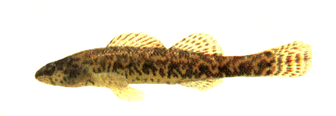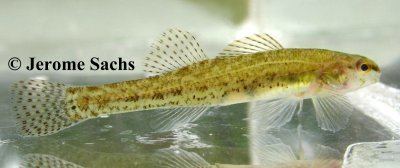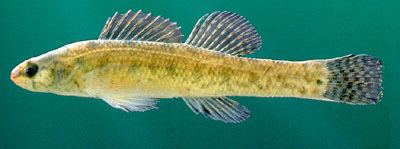Phylum Chordata Rank Species | Species E. fusiforme | |
 | ||
Similar Etheostoma, Greenside darter, Blueside darter, Etheostoma rufilineatum, Speckled darter | ||
Interesting swamp darter behavior
The swamp darter (Etheostoma fusiforme) is a species of darter endemic to the eastern United States.
Contents
- Interesting swamp darter behavior
- Swamp darter collected in north florida
- Description
- Distribution
- Ecology
- Lifecycle
- Management
- References
Swamp darter collected in north florida
Description

This species can reach a length of 5.9 cm (2.3 in), though most are only about 4 cm (1.6 in). It is typical of the subgenus Hololepis in having a small head and mouth and a highly arched, incomplete lateral line. Neither breeding males nor females develop bright colors. The upper body is typically light green, yellow, or tan, while the venter is white or yellow and many have a few scattered melanophores or may have large black spots. The midside has a band of 10–12 dark brown rectangles. Some individuals have small dark dorsal saddles. Their fins are lightly banded or have scattered melanophores. Orbital bars are present and usually prominent.
Distribution

E. fusiforme ranges from southern Maine along the Atlantic Coast and Gulf Coast to about the Texas-Louisiana border and north in the former Mississippi Embayment to Kentucky. Records exist for Long Island. Almost all localities are below the Fall Line or, in the northeast, along the Seaboard Lowlands. The species is generally common along the Atlantic Coast, and sporadic along the Gulf Coast and in the Mississippi River tributaries. An introduced population exists in the French Broad system in North Carolina. Only two subspecies are found: E. f. fusiforme on the Atlantic Coast from the Waccamaw River, North Carolina north to Maine, and E. f. barratti from the Pee Dee River, South Carolina, south and west throughout the rest of the species' range. It also extends up the Red River drainage as far as northeastern Texas and southeastern Oklahoma, where it is rare. No other darter is found as far south as E. fusiforme.
Ecology

The swamp darter is found in stagnant swamps, bogs, and man-made ponds or slow-flowing, sluggish streams, especially where detritus or aquatic vegetation occurs over mud. Fish color is related to water color; the darkest individuals are in dark-water coastal streams and ponds. It lives in water in which the lower pH values are not typically tolerated by all but a few freshwater species of fish. It also tends to thrive in alkaline waters of northern Florida. The range of water temperature tolerated between Maine and Florida is also impressive. Swamp darters feed on fly larvae, amphipods, and other small crustaceans and insects. Swamp darters tend to be an important element in the diets of young chain pickerel and young largemouth bass, where the species coexist. Human-induced problems for this hardy, widespread, and locally abundant darter do not seem to exist. It thrives under a variety of conditions, including warm water, extreme murkiness or brown coloration, low or high pH, and low oxygen content.
Lifecycle

Spawning is thought to occur in May in New Jersey; elsewhere, breeding individuals have been collected in March, April, and May. Swamp darters are not bashful about spawning. They typically spawn in the same habitats where they are found. The male approaches a female from the rear, mounts her, and beats her with his pelvic fins. The female then leads the male into aquatic plants, where the eggs are deposited singly on leaves. No parental care of the eggs has been observed, and no information regarding the number of males with which females spawn and vice versa. No fighting or display of territoriality is typically observed. For many populations of the swamp darter, maximum longevity is only one year, with very few individuals surviving two years.
Management

Boschung and Mayden (2004) recommended special concern status for Etheostoma fusiforme in Alabama. In Oklahoma, E. fusiforme is apparently one of the rarest fishes. Populations are currently stable in the southern United States. Currently, no management plans for E. fusiforme are recorded, probably because it is not federal- or state-listed as endangered or threatened.



